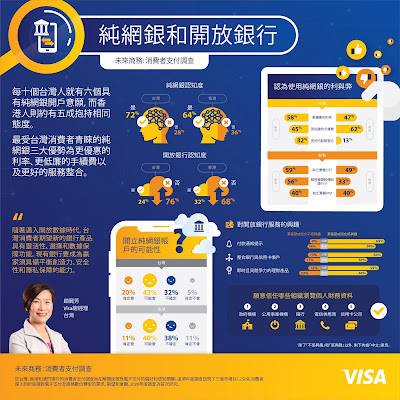·
Taiwan consumers expect better interest rates,
lower fees, better service integration and better
user experience from their
virtual banks
·
Open banking has lower awareness than virtual banking
and only four in ten consumers
are willing to share their personal and financial
data with third parties
TAIPEI, Taiwan, May 27, 2020
– Appetite for virtual banking is strong in Taiwan as about two in three
consumers are open to trying one of the new challenger banks when available,
according to a study by Visa. While open banking products, although of interest
to Taiwan consumers, is met by skepticism as most consumers are not ready to
share access to their financial details in return for these services.[1]
The study indicates that 72 percent of
Taiwanese are aware of virtual banking. The top perceived benefits of virtual
banking are better interest rates (58 percent), lower fees (45 percent), better
service integration (32 percent) and better user experience. The three main
perceived disadvantages of virtual banking are the lack of physical branches
(59 percent), limited services than incumbent banks (56 percent) and absence of
own ATM network (40 percent).
Michelle Jao, General Manager, Visa
Taiwan said: “Visa’s study shows that consumers seek quality digital banking
experiences. We believe the arrival of challenger banks and the emerging open
banking solutions will accelerate industry-wide innovation. Therefore, it would
need collaboration across sectors from government to technology platforms and
providers to other API and data owners such as retailers, telecommunication
companies and utilities.”
Open banking is another initiative that
is gaining traction globally. It is supported by many governments and the
financial industry. It refers to a set of standards that allows consumers to
have their financial institutions share their financial information with
specifically selected organizations. For instance, someone who has multiple
bank accounts and multiple credit cards would be able to give a third-party
access to all their bank and credit card information. This would allow services
such as consolidated overviews of transactions across all banks, expenses
analyses, cost savings advice, and many other services.
Less than half of consumers in Taiwan
(42 percent) have shown interest in open banking-related services. However, the
required sharing of personal information still sees a lot of hesitation.
Payment notifications are a service that interests most (69 percent) followed
by the consolidation of bank and credit card accounts (63 percent); and instant
and more competitive financing products (59 percent).[2]
Utilities and governments are most trusted
with financial data – with a net trust[3] of 17 percent and 10
percent respectively. Banks and telecommunication service providers are next
most trusted organisations in terms of consumer allowing them to access financial
information.
“Safeguarding customers’ personal data
and ensuring maximum security are two crucial steps in advancing open banking
or open API in Taiwan, equally important is the need to educate consumers on
what this is all about – how it works, what they are really signing up for. So,
consumers can then make the right decisions with confidence. This requires
collaboration from all players in the ecosystem,” added Ms. Jao.
For the complete Future of
Commerce: Consumer Payment Attitudes Study 2020 Taiwan edition,
pleasure
visit: https://tw.review.visa.com/partner-with-us/market-insights/futurecommercetw.html
[1] The “Future of Commerce:
Consumer Payment Attitude Study” is conducted by Intuit Research on behalf of
Visa. This online survey was conducted in May 2019 with 1,250 residents in
Taiwan, Hong Kong and Macau. It is intended to track and analyze consumers’ perceptions,
adoption, and attitudes toward cash and non-cash payments.
[2] The “Future of Commerce:
Consumer Payment Attitude Study”
[3] Net trust is calculated
as sum of % “trust fully” + % “trust somewhat” - % “distrust somewhat” - %
“completely distrust” in the survey answers
